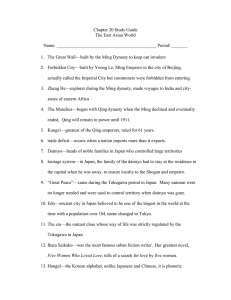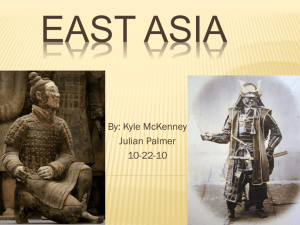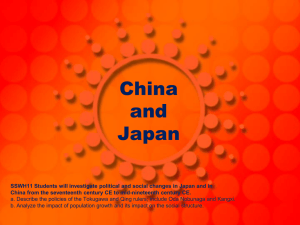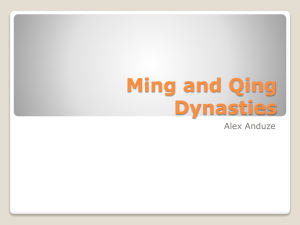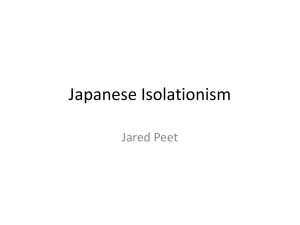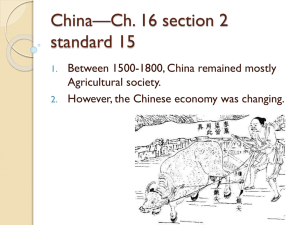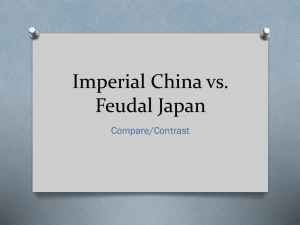Ch. 19 -- Notes Student
advertisement
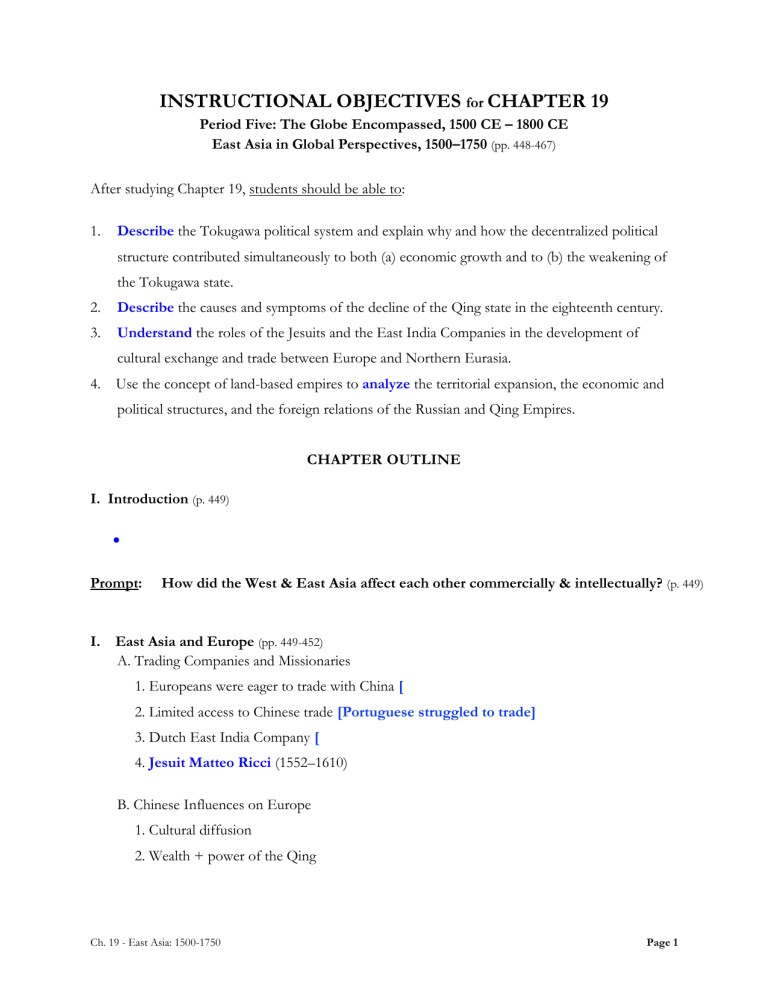
INSTRUCTIONAL OBJECTIVES for CHAPTER 19 Period Five: The Globe Encompassed, 1500 CE – 1800 CE East Asia in Global Perspectives, 1500–1750 (pp. 448-467) After studying Chapter 19, students should be able to: 1. Describe the Tokugawa political system and explain why and how the decentralized political structure contributed simultaneously to both (a) economic growth and to (b) the weakening of the Tokugawa state. 2. Describe the causes and symptoms of the decline of the Qing state in the eighteenth century. 3. Understand the roles of the Jesuits and the East India Companies in the development of cultural exchange and trade between Europe and Northern Eurasia. 4. Use the concept of land-based empires to analyze the territorial expansion, the economic and political structures, and the foreign relations of the Russian and Qing Empires. CHAPTER OUTLINE I. Introduction (p. 449) Prompt: I. How did the West & East Asia affect each other commercially & intellectually? (p. 449) East Asia and Europe (pp. 449-452) A. Trading Companies and Missionaries 1. Europeans were eager to trade with China [ 2. Limited access to Chinese trade [Portuguese struggled to trade] 3. Dutch East India Company [ 4. Jesuit Matteo Ricci (1552–1610) B. Chinese Influences on Europe 1. Cultural diffusion 2. Wealth + power of the Qing Ch. 19 - East Asia: 1500-1750 Page 1 C. Japan + the Europeans 1. Jesuits came to Japan in the late 1500s 2. “Closed” country policy 3. Some overseas trade Prompt: What was the effect of Japanese unification on Korea and Japan? (p. 453) II. Japanese Unification + the Imjin War (pp. 453-454) 1. Daimyo [“great names”, Japanese warlords + landowners in control] 2. Hideyoshi [ 3. Korean and Japanese languages are closely related 4. Koreans and their Chinese allies were defeated by the Japanese 5. Hideyoshi died in 1598 6. The Manchu [Federation of Northeast Asian people who founded Qing Empire] Prompt: How did Japan respond to unification and domestic peace, and Korea to the ravages of the Imjin War? (p. 454) III. Tokugawa Japan + Choson Korea, to 1800 (pp. 454-456) A. Japanese Reunification + Economic Growth 1. Tokugawa Shogunate (1603) 2. Wholesale rice exchanges 3. Samurai became bureaucrats and consumers of luxury goods, spurring the development of an increasingly independent merchant class B. Japanese Elite Decline + Social Crisis 1. Patterns of population growth and economic growth 2. Tokugawa system undermined 3. Decentralized political system 4. Tokugawa Japan’s transformation from a military to a civil society Ch. 19 - East Asia: 1500-1750 Page 2 C. Choson Korea 1. Choson dynasty 2. Model Confucian state with a very strict social hierarchy. Prompt: How did China deal with military and political challenges both inside and outside its borders? (p. 456) IV. From Ming to Qing (pp. 456-463) A. Ming Economic Growth, 1500–1644 1. Cultural brilliance and economic achievements of the early Ming 2. Climate change 3. Flow of New World silver into China in the 1500s + early 1600s 4. In addition to these global causes of Ming decline, there were also internal factors particular to China. B. Ming Collapse + the Rise of the Qing 1. The Ming also suffered from increased threats: 2. Rebel forces led by Li Zicheng overthrew the Ming in 1644 3. A Manchu imperial family ruled the Qing Empire C. Emperor Kangxi 1. Kangxi (r. 1662–1722) took formal control over his government in 1669 (at the age of 16) 2. Kangxi negotiated a treaty with Russia D. Tea & Diplomacy 1. Qing were eager to expand trade, but they wanted to control it to be able to tax it more efficiently and to control piracy and smuggling. 2. British East India Company (late 1700s) 3. The Macartney mission (1793–1794) Ch. 19 - East Asia: 1500-1750 Page 3 E. Population Growth + Environmental Stress 1. Population explosion 2. Increased environmental stress 3. The Qing depended on local elites to maintain local order V. Conclusion (p. 463) VI. Issues in World History: The Little Ice Age (pp. 466-467) NOTE: Beginning in the 14th century, there was a decrease in mean temperatures, often referred to as the Little Ice Age, around the world that lasted until the 19th century, contributing to changes in agricultural practices and the contraction of settlement in parts of the Northern Hemisphere. Ch. 19 - East Asia: 1500-1750 Page 4 Actively Read the following paragraphs. Theme: Creation, Expansion, and Interaction of Economic Systems (ECON) This theme surveys the diverse patterns and systems that human societies have developed to produce, distribute, and consume desired goods and services across time and place. It explores how these interactions influence cultural and technological diffusion, migration, state formation, social classes, and human interaction with the environment. This theme analyzes and compares major transitions in human economic activity, such as the growth and spread of agricultural, pastoral, and industrial production; the development of various labor systems associated with these economic systems (including different forms of household management and the use of coerced or free labor); and the ideologies, values, and institutions (such as capitalism and socialism) t hat sustained them. This theme also calls attention to patterns of trade and commerce between various societies, with particular attention paid to the relationship between regional and global networks of communication and exchange, and their effects on economic growth and decline. These webs of interaction strongly influence cultural and technological diffusion, migration, state formation, social classes, and human interaction with the environment. Key Concept: State Consolidation and Imperial Expansion Empires expanded and conquered new peoples around the world, but they often had difficulties incorporating culturally, ethnically, and religiously diverse subjects, and administrating widely dispersed territories. Agents of the European powers moved into existing trade networks around the world. Around the world, empires and states of varying sizes pursued strategies of centralization, including more efficient taxation systems that placed strains on peasant producers, sometimes prompting local rebellions. Rulers used public displays of art and architecture to legitimize state power. African states shared certain characteristics with larger Eurasian empires. Changes in African and global trading patterns strengthened some West and Central African states — especially on the coast; this led to the rise of new states and contributed to the decline of states on both the Ch. 19 - East Asia: 1500-1750 Page 5 coast and in the interior. I. Rulers used a variety of methods to legitimize and consolidate their power. A. Rulers used the arts to display political power and to legitimize their rule. 1] Give examples of the arts as displays of political power: B. Rulers continued to use religious ideas to legitimize their rule. 2] Give examples of these religious ideas: Key Concept — Although the world’s productive systems continued to be heavily centered on agriculture, major changes occurred in agricultural labor, the systems and locations of manufacturing, gender and social structures, and environmental processes. I. As social and political elites changed, they also restructured ethnic, racial, and gender hierarchies. II. Both imperial conquests and widening global economic opportunities contributed to the formation of new political and economic elites. Give illustrative examples of new elites: Ch. 19 - East Asia: 1500-1750 Page 6 III. The power of existing political and economic elites fluctuated as they confronted new challenges to their ability to affect the policies of the increasingly powerful monarchs and leaders. Give illustrative examples of existing elites: IV. Some notable gender and family restructuring occurred, including demographic changes in Africa that resulted from the slave trades. Give illustrative examples of gender and family restructuring: V. Recruitment and use of bureaucratic elites, as well as the development of military professionals, became more common among rulers who wanted to maintain centralized control over their populations and resources. Give illustrative examples of bureaucratic elites or military professionals: Ch. 19 - East Asia: 1500-1750 Page 7
